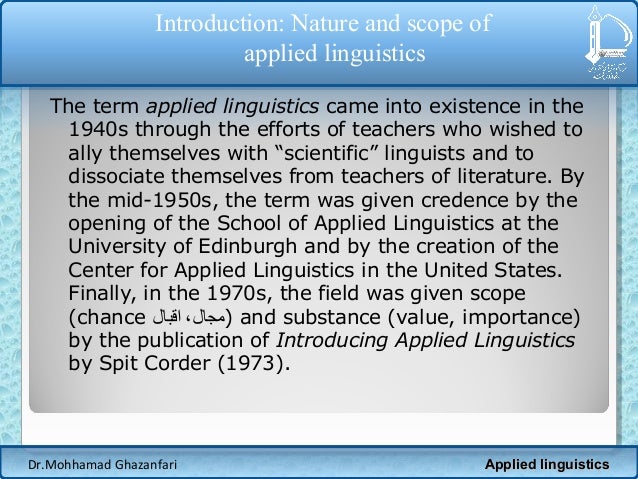The term applied linguistics refers to the interdisciplinary field that aims to seek out, identify, and provide solutions to real-life problems that result from language-related causes. This research encompasses a wide variety of fields including language acquisition, language teaching, literacy, literary studies, gender studies, speech therapy, discourse analysis, censorship, professional communication, media studies, translation studies, lexicography, and forensic linguistics.
Applied Linguistics vs. General Linguistics

The study and practice of applied linguistics are specifically geared toward addressing practical issues as opposed to theoretical constructs. Fields in which applied linguistics routinely come into play are education, psychology, communication research, anthropology, and sociology. General linguistics or theoretical linguistics, on the other hand, deal with language itself, not as that language applies to the people who are using it.

Feb 08, 2012 In his second chapter: ‘The long silence: From Direct Method to meaning focus’, Cook traces the development of teaching methodology in the past century looking in particular at the persistent disregard of and opposition to translation in mainstream Applied Linguistics, Second Language Acquisition (SLA) and Language Teaching and Learning.
One way to better understand what distinguishes the two disciplines is to make an analogy between them and connotative versus denotative word meanings in grammar. Denotative words generally have a single meaning that isn't open to interpretation. Take, for example, the word a 'door.' Generally speaking, when you look at a door, you know it's a door—not a shoe or a dog. Like denotative words, general or theoretical linguistics are based on a set of predetermined rules that are understood to have a uniform meaning.
Connotative words, on the other hand, tend to be conceptual rather than concrete. Concepts, which are open to interpretation, are often understood differently by different people. Take, for example, the concept of 'happiness.' As we know, one person's happiness can be another person's misery. As with connotative meaning, applied linguistics focuses on language with regard to how people interpret—or misinterpret—meaning. In other words, both applied linguistics and connotative meaning are dependent on human interaction and reaction.
Language-Based Anomalies
[It's the] language-based problems in the world that drive applied linguistics.'—From 'The Oxford Handbook of Applied Linguistics' by Robert B. Kaplan
Applied linguistics tackles a broad scope of issues that include learning new languages, or assessing the validity and reliability of the language we encounter every day. Even small variations in language—such as a regional dialect or the use of a modern versus an archaic vernacular—can have an impact on translation and interpretations, as well as usage and style.
To understand the importance of applied linguistics, let's look at how it relates to the study of a new language. Teachers and academics must determine which resources, training, practice methods, and interactive techniques best solve the difficulties related to teaching someone a language with which they're not familiar. Using research in the fields of teaching, sociology, and English grammar, experts attempt to create temporary-to-permanent solutions to these issues. All of these disciplines are tied to applied linguistics.
Applying Theory to Practice
One of the main goals of applied linguistics is to determine practical applications for linguistic theories as they apply to the evolution of everyday language usage. Initially targeted toward teaching, the field has become increasingly far-reaching since its inception in the late 1950s.
Alan Davies, whose career spanned four decades as a professor of applied linguistics at the University of Edinburgh, wrote, 'There is no finality: the problems such as how to assess language proficiency, what is the optimum age to begin a second language, [and the like] may find local and temporary solutions but the problems recur.'
As a result, applied linguistics is a constantly evolving discipline that changes as frequently as the modern usage of any given language, adapting and presenting new solutions to the ever-evolving problems of linguistic discourse.
Sources
- Brumfit, Christopher. 'Teacher Professionalism and Research' in 'Principles and Practice in Applied Linguistics: Studies in Honour of H.G. Widdowson.' Oxford University Press, 1995
- Cook, Guy. 'Applied Linguistics.' Oxford University Press, 2003
- Davies, Alan. 'An Introduction to Applied Linguistics: From Practice to Theory,' Second Edition. author Alan Davies. The University of Edinburgh Press, September 2007
This is a timely and important book. It is a welcome attempt to get translation out of the taboo zone in the language sciences and to show that it is well worth taking a fresh look at this age-old, but curiously neglected multilingual practice. Cook questions this neglect on many fronts, and argues convincingly for re-considering translation in language learning and teaching, claiming that the integration of translation in a teaching program is useful for most language learners.

Applied Linguistics Programs
In his first chapter, Cook looks at the reasons for outlawing translation, a process that began at the end of the 19th century, when the use of translation in the so-called ‘Grammar Translation Method’ came under heavy attack. Wilhelm Vietor’s 1882 slogan ‘Der Fremdsprachenunterricht muss umkehren!’ (‘Language teaching must turn around’) epitomizes this demand for abandoning the grammar translation method calling for a more ‘natural’ way of...